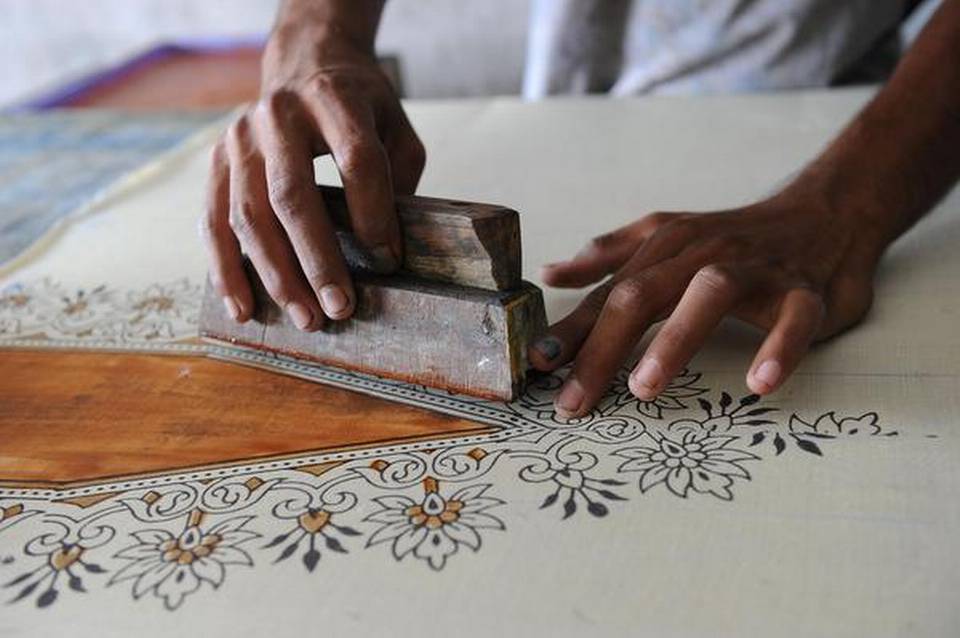Ajrakhpur (Kutch ), GUJARAT :

Khalid Amin Khatri’s favourite theme is clouds floating atop mountains
He grew up in a world of symmetry. The perfectly synchronised movement of wooden blocks from a plate of colour onto long stretches of cloth, and the accompanying sound of a regular, dull beat, are deeply ingrained in Khalid Amin Khatri.
This is, after all, Ajrakhpur, in the Kutch region of Gujarat , and he was born the son of generations of ajrakh printers. Khatri, however, was bored by the regularity. He wanted to capture his imagination on a piece of cloth, to bring the clouds and the mountains, shrines and monuments down to his canvas.
So that’s what he did.
Khatri, 26, calls himself an artist — more than an artisan. A step away from the traditional ajrakh block-printing that relies on uniformity of design, Khatri’s work is dominated by asymmetricity. But it’s more than that. “Each of my creations has a theme,” he tells us, as he unfolds piece after piece, each hand crafted, each guided by a theme. Unlike the traditional form that mostly prints floral motifs and geometrical designs, Khatri’s designs are guided by his imagination. His favourite theme, for example, is clouds floating atop mountains.
Different strokes
Showing us one such piece — it has a river, flowers, bushes, and yes, clouds and mountains — Khatri recalls a time, not even 10 years ago, when other artisans in his village would look at him with dismay. “‘Why are you hell-bent on destroying the art form,’ they would ask,” he says, smiling. “But I didn’t care. I always knew if I was going to do Ajrakh, I would do something different.”
Khatri was a child when the 2001 Bhuj earthquake destroyed their village, Dhamadka, and the entire community of artisans moved to Ajrakhpur. Most villagers went back to their craft, but Khatri’s father, Amin Khatri, stopped working on ajrakh and instead opened a grocery shop.
He did not however discourage his son from learning the art form in his uncle’s workshop. But traditional ajrakh could not capture the boy’s interest, and he ran away to Mumbai. He was just a teenager and he had found himself a job as a telemarketer.
“I lasted just six months there,” he smiles sheepishly. “I decided to come back to my world — but to innovate and leave my mark.” In 2010, his uncle, Dr. Ismail Khatri, encouraged him to study textile design at Kala Raksha Vidyalaya.
During the one-year course, one theme caught Khatri’s fancy: concept design. “Concept development was completely new to me. We were taught how to develop a theme; it was aligned to what I wanted to do,” he says.
Dargah on cloth
Khatri’s first finished product as a student was a black stole on which he made mountains and clouds. “A lady from the U.S. had come to see our products and when she saw my creation, she said my talent was qudrati, that I was a natural, like M.F. Husain. I didn’t even know who Husain was then,” he says. The stole sold for ₹50,000.
Since then, Khatri’s visually arresting work has gained widespread popularity, both among Ajrakhpur’s regular customers and new buyers. His work is unusual, for instance, a stole with a vivid image of Mumbai’s Haji Ali Dargah, complete with the half-submerged road leading to it. Or the white Rann of Kutch printed on a scarf. He also does a lot of abstract work, both on silk — modal, mashroo, etc. — and on cotton.
“I spend a lot of time on each piece and make sure it is unique. I take at least two hours to print a two-metre piece of cloth, when traditional ajrakh block-printing would have taken 10 minutes,” he says.
He gets wooden blocks made for every design and theme, and uses paper to cover portions of the cloth in order to break the symmetry; he hand-paints some as well. This means that unlike the traditional six metre long ajrakh prints, he usually does stoles, scarves and dupattas. “But I recently got an order for a cotton sari and I did that,” he says.
Khatri has travelled across the country for exhibitions and his wares are displayed at fashion shows. A lot of his orders come from overseas. “These,” he says, showing a pile of abstract art stoles on his bed at home, “are ready to be shipped to a textile designer and collector in the U.S.”
Khatri’s work was exhibited at the V&A Museum in London. And he is renowned enough for students from design schools like the National Institute of Fashion Technology (NIFT) and M.S. University (Vadodara) to visit him for learning.
Asked about his future plans, Khatri looks up for a second and then smiles. “I don’t think too much about the future. I enjoy doing what I do. Like, right now, I want to work on a piece that celebrates Delhi, its monuments and landmarks,” he says. His father, who now helps him in his workshop, nods approvingly.
The author is a Gujarat-based freelance journalist.
source: http://www.thehindu.com / The Hindu / Home> Sunday Magazine> Focus> Society / by Azera Parveen Rahman / June 29th, 2019








